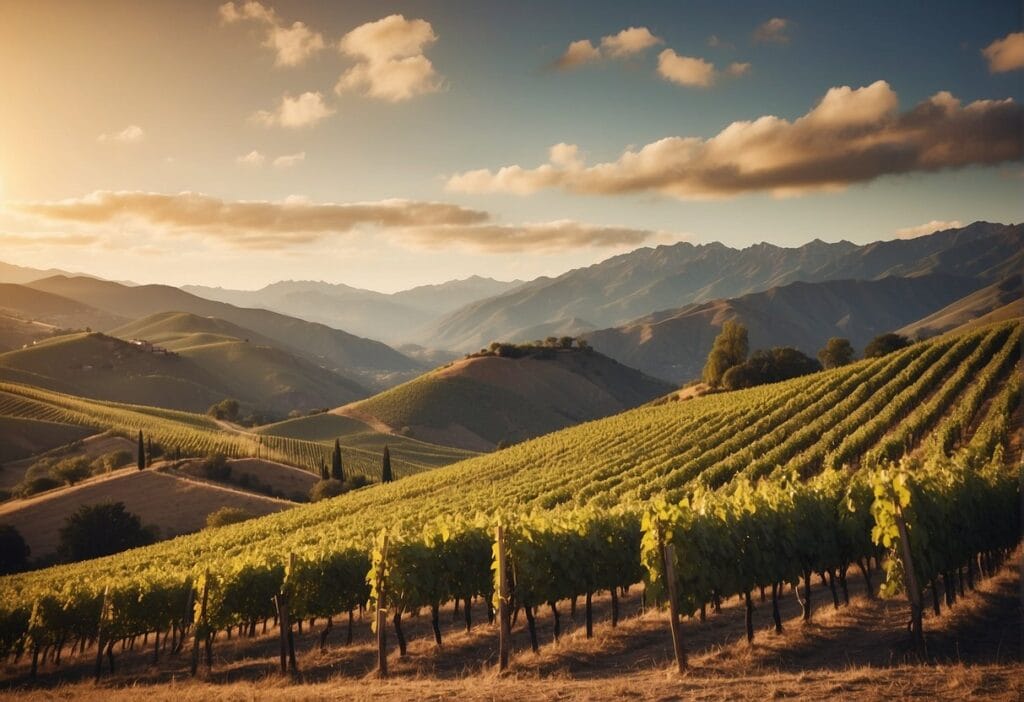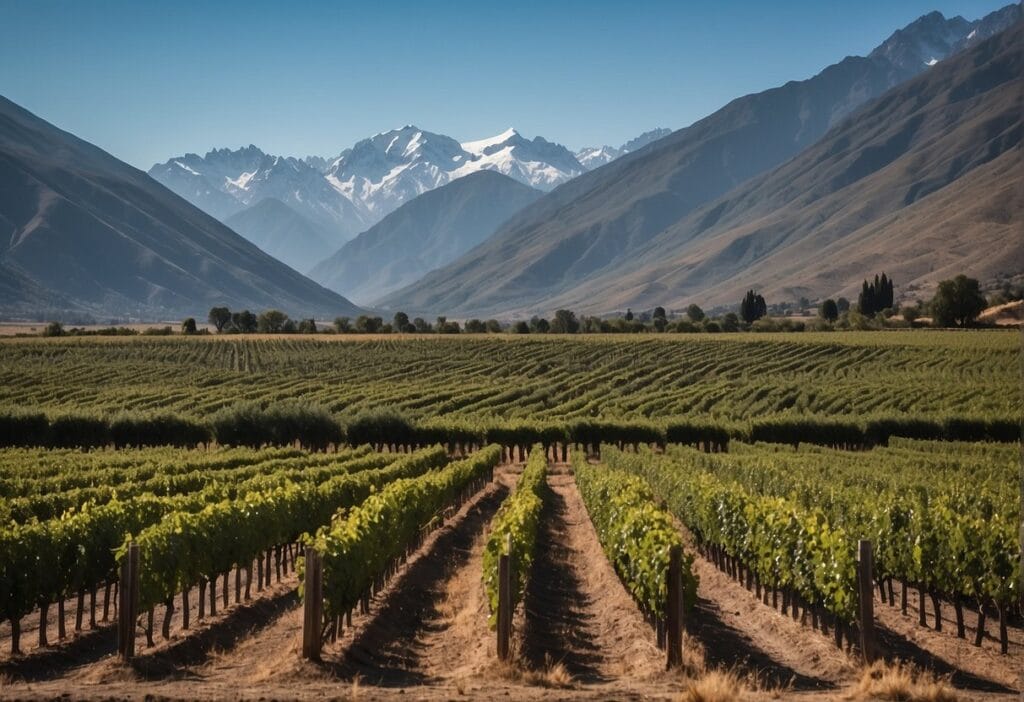France is renowned for its exquisite wines and the beautiful regions from which they hail. Each French wine region boasts its own unique history, culture, and methods of viticulture, contributing to the distinct flavors and characteristics of its wines.
From the full-bodied reds of Bordeaux to the crisp whites of Alsace and the celebrated sparkles of Champagne, the diversity of French wines is a direct reflection of the country’s diverse terroir and winemaking traditions.

As you explore the world of French wine, you’ll discover that the terroir—the combination of soil, climate, and topography—affects each vine and grape differently, creating a complex array of wines.
Wine labels often indicate the region of origin, which can be a guide to understanding the taste profile and quality of the wine. With regions like the Rhône Valley and Provence, French wines offer a palette of flavors that can complement a myriad of cuisines and occasions.
Key Takeaways
- Each French wine region provides distinct flavors and characteristics reflected in their wines.
- Terroir plays a critical role in shaping the unique profile of French wines.
- Understanding regional labels helps in selecting wines that suit your taste preferences.
The History of French Winemaking
As you explore the rich tapestry of French winemaking, you’ll discover its roots in ancient history and how it has evolved into a system with protected appellations, showcasing the country’s dedication to quality and tradition.
Ancient Origins and Medieval Times
French winemaking dates back over 2,600 years, beginning with the Greek foundation of Massalia, modern-day Marseille. The earliest introductions of grapevines to the country were due to this Greek influence. Historical records indicate that by the 6th century BC, viticulture was well underway in France, thanks to the ancient Greek settlers and later the Romans who expanded vine planting throughout the land.
Modern Winemaking and Appellations
Moving into more recent centuries, French winemaking has become synonymous with an intricate system of Appellations d’Origine Contrôlée (AOC). This system, now also known as Appellation d’Origine Protégée (AOP), is a strict legal framework that governs the production and geographical labeling of French wines.
It ensures that each wine reflects the character of the region where the grapes were grown, turning French winemaking into an art form respected globally. French wines are not just beverages but expressions of culture, geography, and tradition, represented by each AOC designation.
Major Wine Regions of France
When exploring France, you discover an array of prestigious wine regions, each with unique characteristics and beloved vineyards.
Bordeaux is a renowned region where the Mediterranean climate nurtures world-class reds, including those from appellations like Médoc and Margaux. You can enjoy a variety of tours and tastings, experiencing the depths of Bordeaux wines.
Journey to the Loire Valley where you’re greeted by a diverse landscape of wines. Here, the Upper Loire is known for its crisp Sauvignon Blancs, while the Middle Loire offers the celebrated Chenin Blancs and Cabernet Francs. The Lower Loire excels with fresh Muscadet.
In Burgundy, revered for Pinot Noir and Chardonnay, you’ll find a complex classification system reflecting the region’s thorough attention to terroir. The beauty of Burgundy wines lies in their nuance and expressiveness.
The sparkling Champagne region is the birthplace of the eponymous bubbly, crafting wines through a meticulous méthode champenoise. Its fame and quality are undisputed, with each bubble telling the tale of its rigorous process.
Head east, and you’ll discover Alsace. Its picturesque vineyards are known for aromatic whites like Riesling and Gewürztraminer, which reveal influences from both France and Germany due to the region’s unique history.
The Rhône Valley offers robust reds and aromatic whites, with the northern part championing Syrah and the southern areas blending varietals in Châteauneuf-du-Pape.
Provence and Languedoc-Roussillon, bathed in sunlight and with a strong Mediterranean influence, offer a variety of wines, from bold reds to refreshing rosés.
Corsica, with its mountainous terrain and marine influence, adds unique varietals to France’s wine mosaic, while Savoie and Jura are hidden gems with distinctive varieties that express their alpine origins.
Lastly, Beaujolais is your go-to for approachable, fruity reds, celebrated annually with the release of Beaujolais Nouveau.
Bordeaux

When you explore the world of French wines, you’ll find the Bordeaux region often at the forefront. This southwest area of France is renowned for its robust red wines, primarily composed of Merlot and Cabernet Sauvignon grapes.
Bordeaux’s unique position between the Garonne and Dordogne rivers creates a microclimate conducive to vineyard cultivation.
The region boasts numerous appellations and sub-regions, offering a wide spectrum of flavors and qualities. Here are a few key takeaways:
- Major Grapes: Predominantly Merlot and Cabernet Sauvignon.
- White Wines: Commonly from the Entre-Deux-Mers area, producing dry white wines.
- Climate: Maritime, with the Atlantic’s influence bringing mild winters and warm summers.
Visiting Bordeaux gives you the opportunity to taste wines straight from their source and understand the intricate craft that goes into each bottle.
With each sip, you’ll learn why the region’s wines are regarded highly across the globe.
If you’re looking for a rich history and an authentic taste of French viticulture, Bordeaux’s wine offerings are a testament to centuries of winemaking tradition. Treat yourself to a glass of Bordeaux wine and savor the depth and character that this iconic region imparts to every blend.
Loire Valley

Nestled along the Loire River, you’ll find the Loire Valley, a region renowned for its picturesque landscapes and exceptional wines. This area, sometimes referred to as the “Garden of France,” offers a diverse range of wines due to its varied climate and soil conditions.
Key Grapes:
- White: Chenin Blanc, Sauvignon Blanc
- Red: Cabernet Franc, Gamay
When you think of Loire Valley wines, your mind might instantly go to the light and zesty whites like those from Sancerre and Pouilly-Fumé, perfect for a refreshing sip on a warm day. But don’t overlook the reds! They can be light and fruity, especially the ones made from Cabernet Franc, which might just be your next favorite.
Wine Styles:
- Whites: From light and minerally to rich and full-bodied
- Reds: Fruity and fresh
- Rosés: Delicately flavored
- Sparkling: Crisp and effervescent
Notable Wine Areas:
- Muscadet: Near the Atlantic, typically providing crisp, salty whites.
- Touraine: Offers a variety, including the versatile Chenin Blanc.
- Anjou-Saumur: Known for both still and sparkling wines.
While exploring Loire Valley wines, you’ll discover the dynamic Chenin Blanc, which can range from honeyed sweetness to lip-smacking dryness.
Pair these wines with seafood or a fresh goat cheese salad to treat your taste buds to the quintessential Loire Valley experience.
Remember to look out for the stunning Saumur castle, a landmark as impressive as the wines themselves. The Loire Valley isn’t just about wine; it’s a historical adventure waiting for you to uncork.
Burgundy

When you discover the Burgundy region, you’re venturing into one of France’s most esteemed and complex wine-making areas. Your journey might begin with Burgundy’s five primary wine growing regions, each offering a distinct taste and character of wine.
- Chablis: You’ll notice the unique taste of minerality, often attributed to the local kimmeridgean soil. It’s renowned for crisp and vibrant Chardonnay grapes.
- Côte de Nuits: Here, you’ll find full-bodied and rich reds, primarily Pinot Noir, that many wine lovers highly covet.
- Côte de Beaune: This is an area known for both reds and whites; however, it’s particularly famous for its elegant and expressive Chardonnay.
- Côte Chalonnaise: If you’re on the hunt for value, the wines here might be more approachable with a wide range of styles.
- Mâconnais: Warmer temperatures here are ideal for ripe Chardonnays with a fruit-forward profile.
Burgundy’s contribution to viticulture is not only in its wines but also in its complex Appellation d’Origine Contrôlée (AOC) system that you might find fascinating.
As you explore Burgundy wines, you’ll learn that this rating system dictates the specific geography and methods required to bear the Burgundy name, ensuring the high quality and specificity of the wines you enjoy.
Champagne
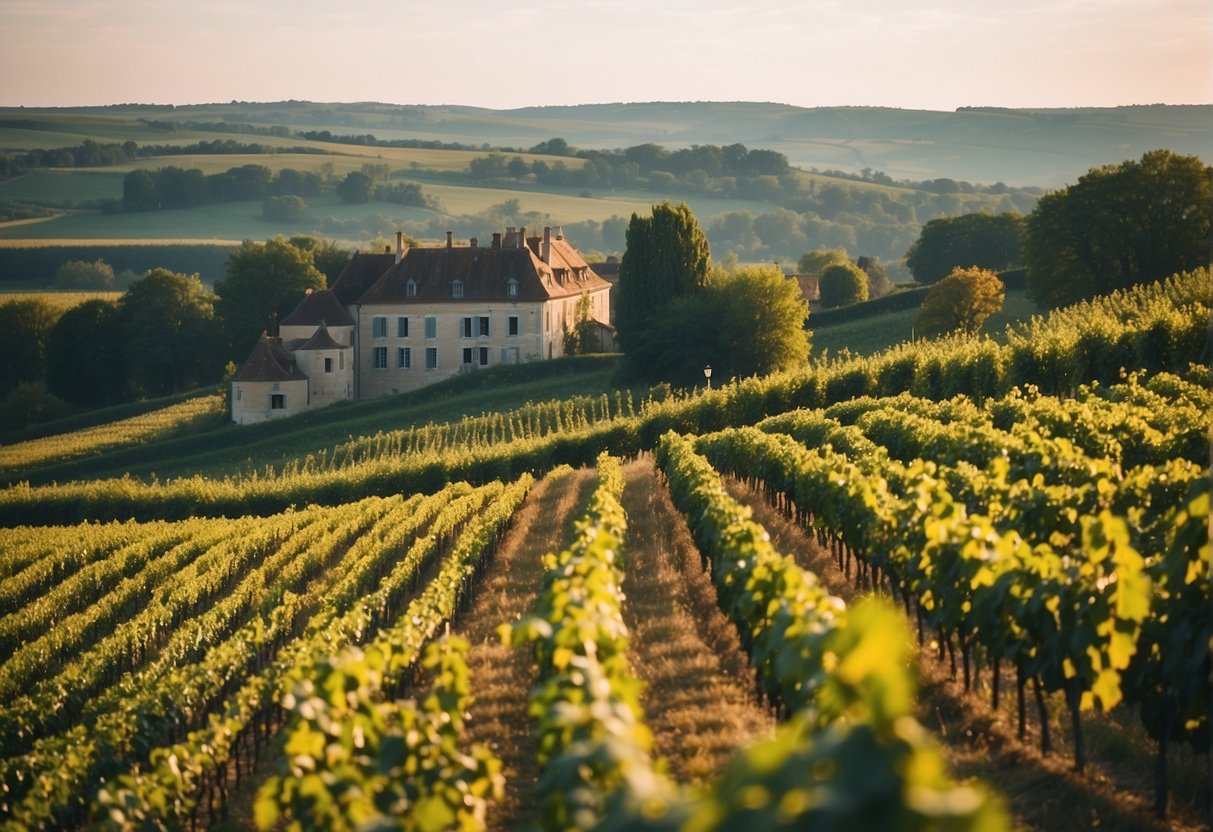
When you explore France’s prestigious Champagne wine region, you’re venturing into the heart of bubbles and elegance. This area is the only place in the world where authentic Champagne, the sparkling wine known for its deep association with celebration, can be crafted.
| Districts of Champagne | Notable Cities |
|---|---|
| Aube | Reims |
| Côte des Blancs | Épernay |
| Côte de Sézanne | |
| Montagne de Reims | |
| Vallée de la Marne |
Your journey may begin about 90 miles east of Paris, where you find that the region’s vines cover approximately 34,300 hectares across 319 villages, or crus.
Here, you can sip on history, as the designated zone for Champagne production was finely defined by legislation back in 1927.
While savoring the crisp taste of a flute of Champagne, it’s fascinating to note that certain folklores credit Dom Perignon with the original creation of this fizzy delight. However, the truth is the development of Champagne involved many winemakers over time.
In Reims or Épernay, you can visit the commercial centers of the Champagne industry, home to many of the grande marque houses.
As you tour, engage with the concept of Cuisine du Terroir, intersecting the pleasure of wine with local gastronomy to create a truly immersive experience.
Your appreciation for Champagne may deepen as you learn about the meticulous vineyard practices and the time-honored tradition of Champagne production.
Discover more about the history and culture of the region, from the charming vineyards to historical cities, in this comprehensive guide to Champagne wine region.
Alsace

When exploring the wine regions of France, you absolutely must visit Alsace. Nestled in the northeast of France, this region is famed for its aromatic white wines which you’ll find to be a joy for your palate.
Alsace wines are unique because of their Germanic influence, making it a delightful convergence of French and German wine traditions.
You’ll discover that Alsace is one of the few regions in France to predominantly produce white wine, with the Crémant d’Alsace being a sparkling favorite that might just tickle your fancy.
Here’s a quick look at what makes Alsace wines special:
- Grape Varieties: The region treasures noble grapes like Riesling and Gewürztraminer.
- Wine Styles: From dry and crisp to sweet and luscious, there’s something for every taste.
You could start your journey along the Alsace Wine Route, a picturesque path that winds through vine-covered hills.
With over 51 Grand Cru vineyards split between Bas-Rhin and Haut-Rhin, the wine route promises a plethora of sensory experiences.
Fun Fact: Alsace is one of the only regions in France where the wine bottle shape—a slim, elegant flute—is mandated by law. This distinctive bottle, known as the Flûte d’Alsace, not only houses the region’s exceptional wine but also tells a story of tradition and identity.
If you’re inspired to learn more, delve into the rich tapestry of this wine region with an informative guide or explore its detailed wine map. Happy touring!
Rhône Valley

The Rhône Valley is one of France’s most storied and diverse wine regions. Nestled along the Rhône River from Lyon to the Mediterranean coast, this region is known for its rich history in winemaking.
Northern Rhône is renowned for its full-bodied Syrah wines. You’ll taste the distinctive notes of blackberry, mint, and black pepper in these wines.
Some of the prestigious appellations here include Côte-Rôtie, known for its complex reds, and Condrieu, where the Viognier grape achieves its maximum expression.
Moving down to the Southern Rhône, you encounter a greater diversity of grapes.
The Southern part is famous for its Grenache blends, producing robust and spicy reds. Here lies the renowned Châteauneuf-du-Pape appellation, where wine has been made for many centuries.
| Northern Rhône | Southern Rhône |
|---|---|
| Syrah grape | Grenache blends |
| Côte-Rôtie AOC | Châteauneuf-du-Pape AOC |
| Condrieu AOC | Côtes du Rhône AOC |
Your sensory journey through the Rhône Valley is bound to be exciting as you explore wines ranging from powerful and aromatic reds to lively and sophisticated whites.
Whether you prefer a complex and aged wine or something fresh and fruit-forward, the Rhône Valley has a bottle that will catch your fancy.
If you’re interested in discovering more about the best hotels in the Rhône, you can find recommendations and discounts to make your stay as pleasing as the wines Rhone In France – The 10 Best Hotels. For history enthusiasts, learning about the 1,900-year-old secrets of an ancient winery can be as enriching as sipping a glass of its vintage The 1,900-Year-Old Secrets.
Provence
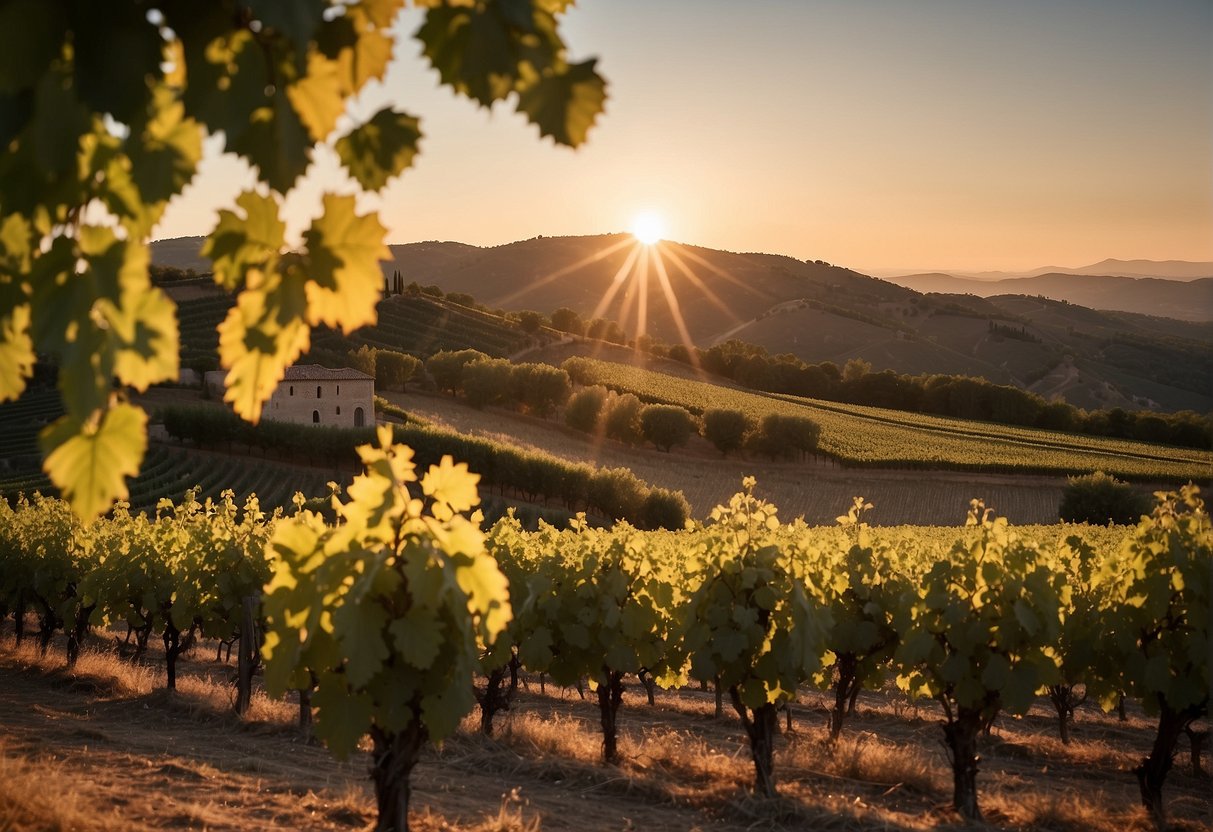
Provence is a picturesque wine region in the southeast of France, famed for its rosé wines. When you explore Provence, you’ll discover a landscape renowned not only for its natural beauty but also for its vast vineyards.
Grapes that thrive in this Mediterranean climate include Rolle (aka Vermentino), Ugni Blanc (aka Trebbiano), and Grenache Blanc among others.
You may also encounter wines made from regional grapes like Pascal and Spagnol, though these are less common today.
Here’s a quick look at the wine production in Provence:
- Rosé: 88%
- Red: 9%
- White: 3%
Rosé wine from this region accounts for a substantial portion of the world’s production, with France as the primary market.
Your palate will savor the spicy, full-flavored reds that some critics believe to be the region’s best-kept secret.
| Wine Types | Percentage of Production |
|---|---|
| Rosé | 88% |
| Red | 9% |
| White | 3% |
Keep in mind that while rosé is the star of the show, Provence also offers robust reds and crisp whites worth your attention.
Each wine tells a story of the region’s rich history and the winemakers’ mastery. So, when you sample a glass from Provence, you’re not just tasting wine; you’re experiencing centuries of winemaking tradition with every sip.
Languedoc-Roussillon

Languedoc-Roussillon is a dynamic wine region located in southern France, offering you a diverse range of wines. Notably, it’s recognized for its vin de pays labeled Vin de Pays d’Oc, a testament to the region’s quality and variety.
Here, you’ll find wines produced along the coastal Mediterranean stretch, running from Provence to the Pyrenees at the Spanish border.
This region doesn’t just impress with its location; it’s also a powerhouse of production. In fact, Languedoc-Roussillon is responsible for one in every three French wines with an appellation designation.
Key Appellations: The area is known for its key appellation: the Languedoc AOC, which encompasses a broad range of dry table wines in red, white, and rosé varieties.
Geography: Coastal plains and mountain ranges shape the vineyards, creating a diversity of microclimates.
Wine Characteristics:
- Reds: Typically robust and full-bodied
- Whites: Known for their freshness and aromatic complexity
- Rosés: Enjoyed for their crispness
The region is also becoming a favorite among wine enthusiasts looking for great value wines. Languedoc-Roussillon wine isn’t just a drink; it’s a reflection of the area’s rich culture and heritage.
For a more detailed exploration of what makes Languedoc-Roussillon’s wines special, delve into the The Ultimate Guide To Languedoc Wine.
Whether for an epicurean adventure or to expand your wine repertoire, this region holds a treasure trove of vinous delights waiting for you to discover.
Other Notable Regions

While many wine enthusiasts flock to the well-documented vineyards of Bordeaux and Burgundy, France has other wine regions that offer remarkable vintages and inviting landscapes. To enhance your wine-tasting journey, consider exploring these lesser-known yet noteworthy areas.
The Rhône Valley is a treasure for lovers of full-bodied red wines. Here, you can indulge in the robust flavors of Syrah and Grenache, which flourish in this revered terroir.
Get acquainted with the Rhône Valley’s wine heritage by visiting the historic vineyards that stretch from Lyon to the Mediterranean coast.
Moving north, you’d encounter the Loire Valley, renowned for its floral whites and picturesque châteaux. The vineyards in this region specialize in Sauvignon Blanc, with notable appellations such as Sancerre and Pouilly-Fumé leading the charge.
Embrace the crispness of a Loire Valley white as you gaze upon the serene river landscapes.
For a taste of effervescence, Champagne is an essential stop. True Champagne can only come from this hallowed region, synonymous with the world’s most celebrated sparkling wine.
Awaken your palate with the bubbly delights from producers who craft these divine wines using traditional methods passed down through generations.
Lastly, don’t miss out on the diverse offerings of the Alsace region, where you can sample aromatic whites like Riesling and Gewürztraminer.
The wine routes in Alsace will guide you through vine-laden hills to storybook villages, combining scenic beauty with exquisite tastings.
Understanding French Wine Labels

When you pick up a bottle of French wine, the label can tell you a great deal about the wine’s quality, origin, and character. Learning to read these labels is key to choosing a wine that fits your preferences.
Deciphering Appellation Classifications
French wine labels are anchored in a strict classification system known as the Appellation d’Origine Contrôlée (AOC) or the broader Appellation d’Origine Protégée (AOP).
These classifications ensure that each wine meets specific criteria related to geography, grape varieties, and production methods. When you see an AOC or AOP label, you can be assured that the wine adheres to stringent regional standards.
- AOC (Appellation d’Origine Contrôlée): Tight regulations, specific to localized areas.
- AOP (Appellation d’Origine Protégée): European Union standardization, similar to AOC but applied across a wider region.
Some bottles may be labeled as Vin de Pays, indicating a country wine which offers a step above table wine, with fewer restrictions than AOC/AOP wines but still linked to a specific region.
Vintage and Chateau Information
The vintage year on a bottle of French wine tells you the harvest year of the grapes. This is not just a date; it’s a snapshot of the region’s climate and weather patterns for that year, which significantly affects the taste and quality of the wine.
Below that, you’ll often find the Château or producer name. This is the estate where the wine was made, which can be a solid indicator of the wine’s style and reputation:
- Vintage: The year the grapes were harvested.
- Chateau/Producer: The estate or winemaker, which can be a mark of quality and prestige.
By understanding these components of French wine labels, you’re better equipped to select a bottle that suits your taste and adds to your appreciation of French viniculture.
Grape Varieties and Their Characteristics

France’s wine regions are renowned for their diverse range of grape varieties, each delivering a unique profile in flavor, aroma, and complexity. Here, you’ll delve into the distinctive qualities of both red and white wine grapes commonly found in these celebrated locales.
Red Wine Grapes
Merlot: You’ll find Merlot to be velvety and easy to drink, with lush flavors of plum and black cherry. This grape is pivotal in the Bordeaux region and is known for its smooth tannins.
Pinot Noir: Esteemed for its versatility and depth, Pinot Noir offers a delicate array of red fruits like strawberries and raspberries. Burgundy’s cool climate allows this grape to flourish, producing wines that are elegant and complex.
Cabernet Sauvignon: Renowned for its bold presence, Cabernet Sauvignon grapes deliver a punch of blackcurrant and often hints of green bell pepper. It’s a staple in Bordeaux, contributing to some of the most age-worthy wines in the world.
Syrah: With its origins in the Rhône Valley, Syrah is your go-to for intense, full-bodied wines featuring spicy and dark fruit notes, and sometimes a distinctive black pepper kick.
Grenache: Often associated with the Southern Rhône and Languedoc regions, Grenache brings warmth to your glass with its generous berry flavors and hints of cinnamon and star anise.
Mourvèdre: Rich and complex, Mourvèdre offers a gamey and earthy profile, complemented by soft red fruit undertones. It’s a common blending partner in regions such as Provence and Rhône.
Gamay: Light, juicy, and fruit-forward, Gamay is primarily associated with Beaujolais. Its wines are appreciated for their youthful freshness and floral hints.
Cabernet Franc: This grape variety adds a bright acidity and a spicy aromatic profile, featuring notes of tobacco and raspberries. It stands out in the Loire Valley.
Carignan: Known for producing deeply pigmented wines, Carignan offers flavors of dark fruit with strong tannins and high acidity, common in the Languedoc-Roussillon area.
White Wine Grapes
Chardonnay: As the most planted white grape in France, Chardonnay ranges from buttery, oak-aged Bourgogne to the lean, mineral-driven styles of Chablis.
Sauvignon Blanc: Celebrated for its crisp, zesty citrus and grassy flavors, Sauvignon Blanc is a star in regions like Loire Valley, particularly in Sancerre and Pouilly-Fumé.
Riesling: This aromatic grape thrives in Alsace, producing highly aromatic wines that can span from bone dry to lusciously sweet, always with a racy acidity and notes of stone fruits and flowers.
Chenin Blanc: With its high acidity, Chenin Blanc can produce a wide array of wines from sparkling to sweet. It’s famously versatile, hailing from the Loire Valley with flavors ranging from yellow apple to honeycomb.
Viognier: Delight in Viognier for its perfumed aromas of peach, tangerine, and honeysuckle. The grape reaches its pinnacle in the northern Rhône but is also found in Languedoc-Roussillon.
Grenache Blanc: A white variant of Grenache, this grape brings bright apple and pear notes to the table, along with a full body and rich texture typical of Southern Rhône whites.
Marsanne: Known for its nutty and pear-like flavors, Marsanne contributes weight and depth to the white wines of the Rhône Valley, especially those from Hermitage and Crozes-Hermitage.
Roussanne: This is another Rhône favorite, offering a floral and herbal character to blends, with sufficient acidity to age gracefully.
Muscat: For a fragrant floral bouquet and sweet fruit flavors, look no further than Muscat, often made into sweet, fortified, or sparkling styles in regions like Alsace and the South of France.
Muscadelle: Though less common, Muscadelle adds a grapey and floral note to the white blends of Bordeaux, including the sweet wines of Sauternes and Barsac.
Savagnin: Unique to the Jura region, Savagnin is typically used in the production of Vin Jaune and offers distinctive nutty flavors likened to fino sherry.
Wine Styles and Types
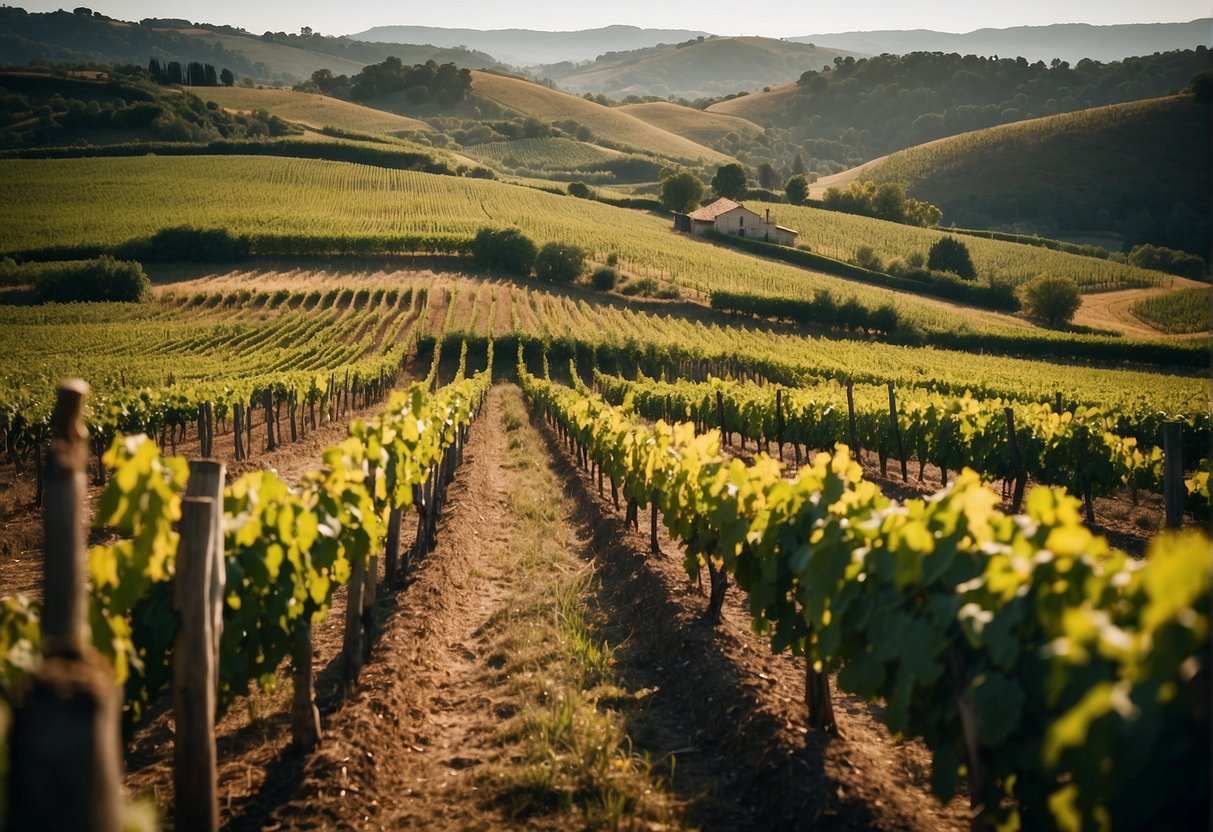
France offers an array of wines that are as diverse as they are distinctive. Whether you prefer the boldness of a red or the crispness of a white, you’ll find traditional and innovative styles to explore.
Red Wines
French red wines are renowned worldwide for their depth and complexity. The grapes grown in specific regions often define the characteristics of the wine produced there.
White Wines
White wines from France range from the light and zesty to the rich and oaked.
Chablis, a famed wine from Burgundy, showcases the steely and crisp nature of unoaked Chardonnay.
On the other hand, a Sauternes from Bordeaux presents you with an exquisitely sweet white wine, which owes its unique flavors to noble rot.
Rosé Wine
French rosé wine strikes a delightful balance between red and white wine characteristics.
Notably, rosé from provinces like Provence boasts a freshness and a pale pink hue, perfect for sipping on a warm day.
Sparkling Wine
The sparkling wines from France are often synonymous with celebration.
While everyone knows Champagne, other regions like Languedoc offer bubbles too. You can find Crémant de Limoux and Blanquette de Limoux, both made with the local Mauzac grape to a traditional method. This gives them a complexity that’s hard to match.
Wine Production
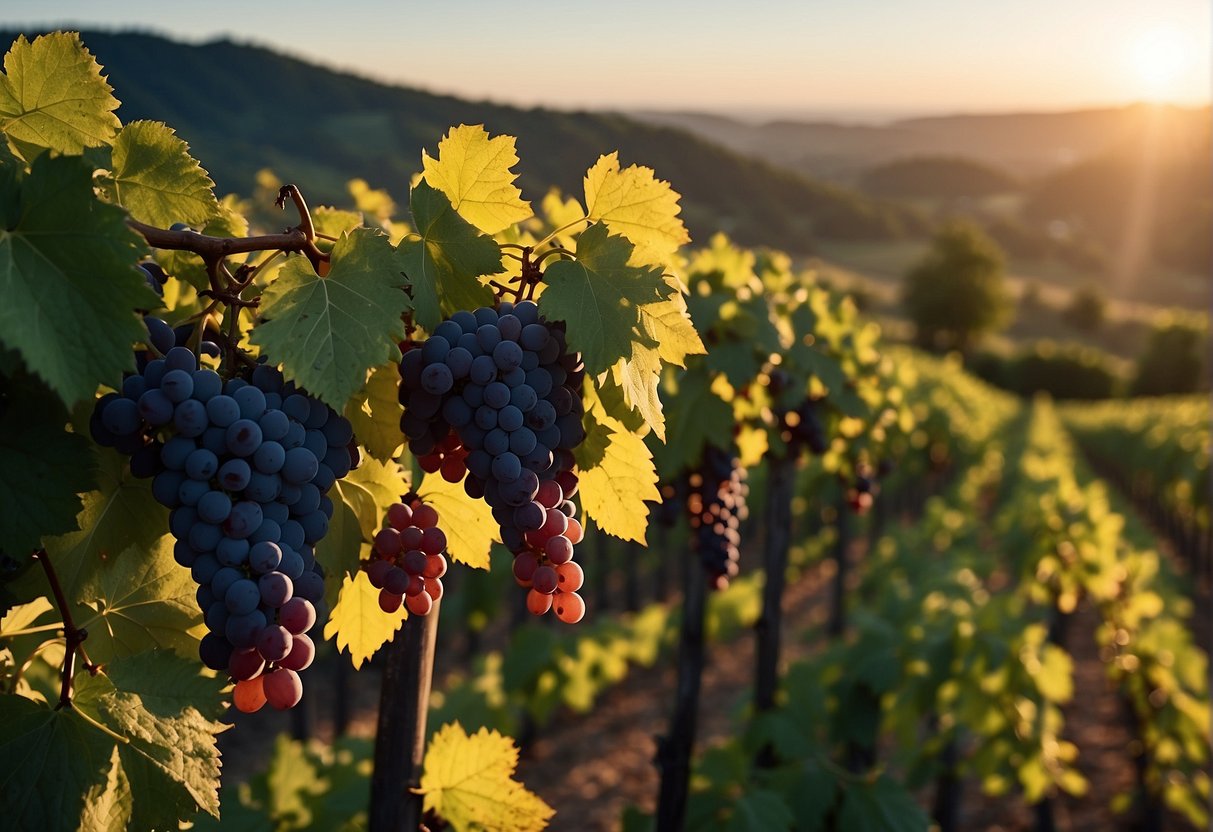
In France, your experience of wine is deeply entwined with the practiced arts of viticulture and vinification, where each step is precise and purposeful.
Viticulture
Viticulture is the cultivation of grapevines for the production of wine.
In French vineyards, particular care is given to the variety of grapevine planted, as it determines the types of wines produced.
For instance, in the Bordeaux region, you’ll find primarily Cabernet Sauvignon and Merlot vines.
The grapevines are meticulously managed throughout the year, following a cycle that includes pruning, canopy management, and soil care. This ensures that the grapes reach perfect maturity.
Vinification
Vinification, or winemaking, begins once the grapes are harvested from the vineyards.
This process is crucial as it transforms the harvested grapes into the distinguished wines you enjoy.
It typically involves:
- Crushing and Pressing: Gentle pressure extracts the grapes’ juice, now called must.
- Fermentation: The must ferments, usually in stainless steel or oak barrels, which adds unique flavors to the wine.
- Aging: The wine is aged, often in barrels, to develop complexity and depth.
In regions such as Burgundy, wines are often aged in oak barrels. Meanwhile, in Occitanie, a wider array of containers may be used. This reflects the diversity of wines produced across France’s numerous wine-producing regions.
Wine Tasting and Terroir
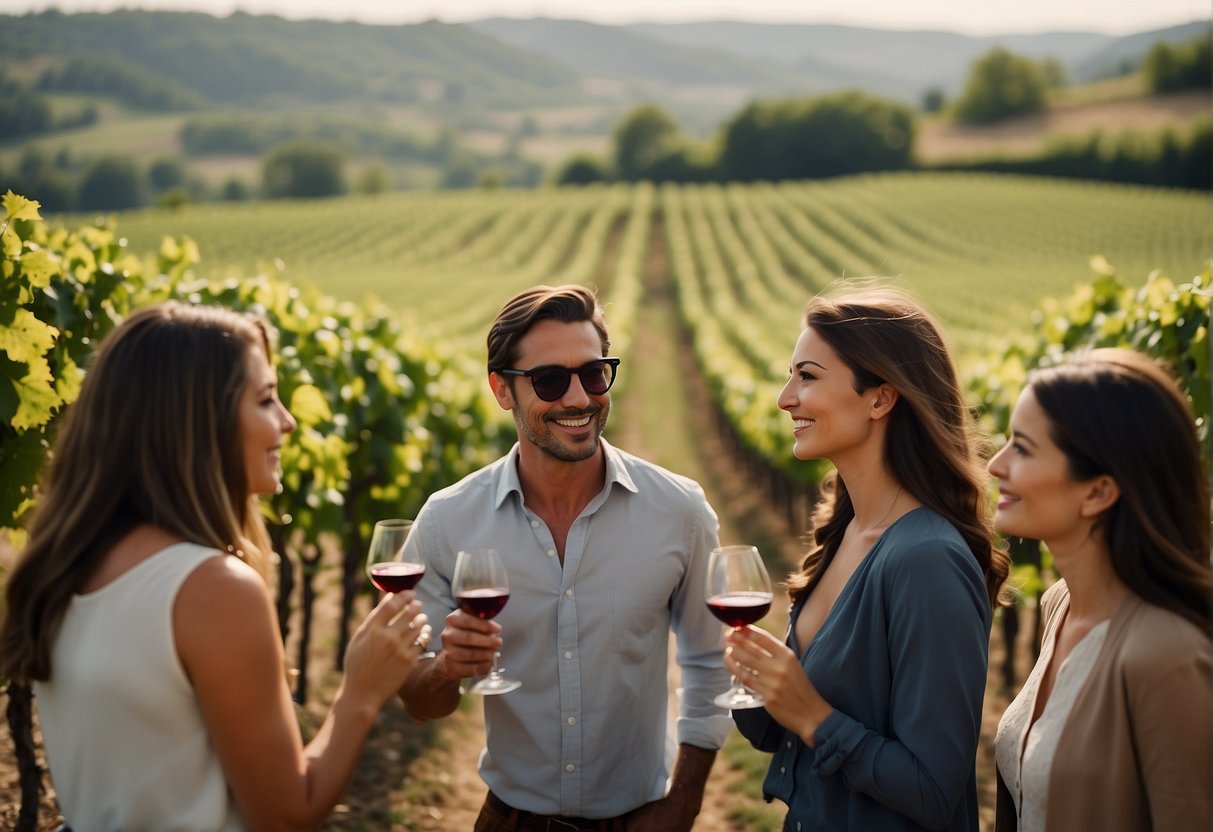
When you embark on a wine-tasting journey through France, you’re not just sipping on fine wine; you’re experiencing the deep-rooted connection between the terroir where the grapes grow and the final product in your glass.
The Influence of Terroir
Terroir is a French term that intricately describes how a particular region’s climate, soils, and aspect (terrain) influence the flavor and characteristics of wine.
In French wines, like those from Beaune in Burgundy, terroir can dictate the quality level of the wine to a significant extent.
Each bottle tells a story of its origin, capturing the essence of the land and climate, offering you a taste that’s unique to that specific location.
- Climate: The climate of a region, whether it’s cool, moderate, or hot, plays a crucial role in the grape varieties that can be cultivated and the types of wine produced.
For instance:
- Cool climates in regions like Champagne contribute to high acidity and freshness in wines.
- Warmer climates give rise to bolder, more robust flavors.
The Art of Tasting Wine
Wine tasting is an art that allows you to become intimately familiar with French wines and discern their fine qualities.
In your wine-tasting endeavors, you’ll want to engage all your senses to fully appreciate the complexities and nuances.
- Look: Examine the wine’s color and clarity. A deeper color can indicate a higher concentration of flavors and, in some red wines, a longer aging potential.
- Swirl: Gently swirl the wine in your glass to release aromas.
- Smell: Inhale deeply to identify the wine’s bouquet. Can you detect fruit, floral, or earthy notes?
- Sip: Take a small sip and let the wine linger on your palate. Consider the balance of sweetness, acidity, tannins, and alcohol.
- Savor: Finally, savor the wine’s finish. How long do the flavors stay with you after swallowing?
By understanding the interplay between terroir and tasting, you elevate your appreciation for the wine’s character and what it represents.
Remember, each sip is a reflection of where it’s from; it’s a geographical snapshot imbued in every glass.
Pairing Wine with Food
When you’re exploring French wines, pairing them with the right food can elevate your dining experience. Each wine region in France offers distinct flavors that complement certain dishes beautifully.
- Chablis: A region in Burgundy known for its crisp Chardonnay. These wines are typically unoaked and go well with seafood, especially oysters. The minerality of Chablis wines can enhance the fresh flavors of the oysters.
- Bordeaux: Here, you can find full-bodied Cabernet Sauvignon which pairs exceptionally with lamb. The strength of Bordeaux wines stands up to the rich taste and texture of lamb dishes.
- Alsace: This region is famed for aromatic whites such as Gewürztraminer and Riesling. They complement spicy dishes and strong cheeses because the sweetness and acidity of the wine provide a balance to the flavors of the food.
- Sauternes: A dessert wine from Bordeaux that’s lusciously sweet and goes well with foie gras or blue cheese.
- Rhône: Known for robust reds like Syrah which pair wonderfully with grilled meats.
Visiting French Wine Regions
Embark on a journey through France’s varied and historic wine regions, from the limestone-rich soils of Chablis to the prestigious estates in Médoc.
Wine Tourism in France
France offers a wealth of options for wine tourism, with each wine region boasting its own distinct character and style of wine.
The country’s Appellation d’Origine Contrôlée (AOC) system ensures that wines reflect the uniqueness of their terroir, offering an authentic experience.
Here’s a brief guide to help you plan your wine exploration:
- Touraine: Known for its fairy tale châteaux and vibrant wines, especially the crisp and aromatic Sauvignon Blancs from Sancerre and Pouilly-Fumé.
- Médoc: Located in the heart of Bordeaux, where you’ll find full-bodied reds made from Cabernet Sauvignon and Merlot blends.
- Beaujolais: Famous for its light and fruity Gamay wines, a perfect introduction for those new to French wines.
- Chablis: This northern Burgundy region produces some of the world’s most exquisite Chardonnays, characterized by their purity and minerality.
Iconic Wineries to Explore
As you tour through France, make a point to visit some of the iconic wineries and vineyards where you can taste world-renowned vintages and learn about winemaking:
- In Bordeaux: Château Latour and Château Margaux are legendary names that offer tours and tastings by appointment.
- In Burgundy: Look for the historic domains in Chablis, where you can savor the unique Kimmeridgian terroir driven Chardonnays.
- In Beaujolais: Discover the picturesque vineyards and taste the nouveau and cru wines that mark this region’s viticulture.
Investing in French Wines
French wines stand at the forefront of the investment landscape, offering both connoisseurs and investors a chance to own a piece of rich viticultural history.
Whether you’re drawn to the robust offerings of Bordeaux, the finesse of Burgundy, or the effervescence of Champagne, understanding the marketplace and the basics of building a collection is essential.
The Marketplace for Fine Wines
In the world of investment, fine wine has carved out a niche for itself, distinguished by a history of stable returns.
Investment-grade wines often hail from acclaimed regions like Bordeaux, home to illustrious names including Château Margaux and Château Haut-Brion.
These regions produce wines that not only delight the palate but also appreciate in value over time.
The Rhône Valley, for instance, is noted for wines that have shown considerable growth, making them attractive assets.
Building a Wine Collection
Your journey into wine investment starts with acquiring bottles that have a proven track record of increasing in value.
Start by focusing on renowned French wines, as they are perennial favorites in auctions and private sales.
A strategic approach involves diversifying your collection with storied vintages from Bordeaux, rare finds from Burgundy, and select champagnes, which consistently remain in demand.
Remember, proper storage is imperative to maintain the integrity and value of your wine investment.
The Cultural Impact of French Wine
Before diving into the particular facets of French wine’s influence, it’s essential for you to understand its deep-rooted connection to French culture, and the expressive role it plays in shaping France’s national narrative and aesthetic expressions.
French Wine in Arts and Literature
French wine doesn’t just tantalize your taste buds; it also enriches the canvas of French arts and literature.
Celebrated in countless paintings, wine is a recurring motif in still lifes and pastoral scenes that reflect French livelihood.
Notably, regions like Lyon and Reims have historically been hubs for artists who’ve immortalized vineyards in their work.
In French literature, references to wine are often symbolic, portraying it as a lifeblood that flows through the veins of French narrative and verse.
Wine’s Role in French Identity
Your bottle of Châteauneuf-du-Pape is more than just wine; it’s a testament to a national identity that’s been cultivated over centuries.
At the core of social gatherings and family meals, French wines are both a pride and a common thread that weaves through the daily fabric of life.
From the rolling vineyards of Savoy to the historic cellars in the heart of major cities, wine is a staple of the French lifestyle, embodying the spirit of both tradition and excellence that the country holds dear.
Sustainable Practices in French Winemaking
In your exploration of French winemaking, you’ll find that sustainability is increasingly at the heart of many vineyards’ philosophy.
The French wine industry is making strides toward eco-friendly practices, recognizing the importance of preserving the environment for the future.
In regions from Occitanie to Alsace, vineyards are embracing organic and biodynamic viticulture.
You’ll be intrigued to find that this includes respecting the lunar and solar cycles, and employing natural treatments. For instance, some winemakers introduce chickens into the vineyards for natural weeding and pest control.
Additionally, find out more about vineyards that foster sustainability by maturing wine to the sound of Beethoven’s music.
Moreover, although there’s no overarching national sustainability system in France, distinct programs are in place.
You’ll discover the Champagne region’s leading initiatives in sustainability and the Haute Valeur Environnementale certification, which recognizes farms committed to ecological methods.
Check the details on regional practices at Discover Sustainable Wine.
Encounters with climate change have propelled the French wine industry to adapt.
Out of necessity, new sustainable farming techniques are deployed to cope with extreme weather patterns, promoting the development of healthier vines capable of withstanding climatic adversities.
This transition is illustrated by vineyards that witnessed the 2021 frost and adapted their practices accordingly.
Regional Wine Events and Festivals
France boasts a vibrant tapestry of wine events and festivals that showcase the rich viticultural heritage of various regions. You’re invited to immerse yourself in these cultural celebrations where the bounty of the vine is the guest of honor.
Notable Festivals to Explore
Festival des Vins D’Aniane
In the coastal town of Aniane, this festival has been a social hub for over 25 years. Experience the blend of communal joy and fine wines in the southern part of France. For more details on the festival’s activities, visit WineTourism.com.Fête des Vendanges
Banyuls-sur-Mer comes alive in October with the Fête des Vendanges, where you can relish traditional Alsatian food specialties paired with an assortment of wines each day. Watch the colorful parade, cortège fleuri, to celebrate the harvest. Feedback and festival information can be found on the official Barr Tourism website.Les Grands Jours de Bourgogne
An event not to be missed in Bourgogne (Burgundy), where you can enjoy wine tastings and meet with producers from the region. Discover the history and sample the terroir at the heartland of fine wines.Vitiloire in Anjou
Recognized for its diversity of wines like Anjou-Villages and Chinon, the Vitiloire event offers you an engaging itinerary through the Loire Valley, with educational workshops and local produce.
Celebrate with Each Sip
In Bandol, the sun-kissed vineyards yield robust reds well worth celebrating. Mark your calendar for the region’s festive occasions that pay homage to the local grape varieties.
You’ll be welcomed with open arms and full glasses to experience the convivial spirit that only wine can cultivate.
The Legal Framework of French Wine Production
When you explore the wines of France, understanding the legal framework is key to appreciating the quality and regional characteristics of each bottle.
Understanding AOC and AOP Regulations
Appellation d’Origine Contrôlée (AOC) and Appellation d’Origine Protégée (AOP) are two cornerstone designations that you’ll encounter within the French wine legal framework. Both are crucial in defining how wine is produced in various regions.
The AOC, which predates the AOP, sets strict regulations on winemaking practices and geographical boundaries. These stipulations cover the types of grape varieties allowed, maximum yield limits, and the minimum alcohol content for wines from a specific area.
For example, the Bandol appellation, located in Provence, is known primarily for its red and rosé wines, primarily from the Mourvèdre grape. Meanwhile, Saint-Chinian, an AOC within the Languedoc-Roussillon region, is esteemed for its reds and rosés composed of Grenache, Syrah, and Mourvèdre.
As you enjoy your wine, remember that an AOC or AOP label ensures it meets the specific, legally defined standards for its region.
Labels and Geographical Indications
Your bottle’s label is more than just a name; it’s a guarantee of origin and quality. Geographical indications like Vin de Pays reflect a tier below AOC/AOP and correspond to the larger regional wines of France, less restrictive but still ensuring certain quality level standards.
Here’s what you must look for on the label:
- The specific appellation: Indicates the wine’s origin and the rules it adheres to.
- Geographical indications: Signal quality level and area of production.
By understanding these labels, you bolster your knowledge of French wine, ensuring each glass you pour reflects the rich heritage of one of the world’s most renowned winemaking countries.
Trends in the French Wine Industry
In recent years, French wines have experienced a dynamic shift as the industry adapts to global changes.
As a connoisseur or enthusiast, you may have noticed an increased focus on eco-friendly practices among producers.
Many vineyards are transitioning to organic and biodynamic methods to cater to a growing environmental consciousness among consumers.
Tasting trends are also changing. There’s a growing preference for wines with a story, leading to a rise in small, artisanal producers gaining recognition alongside the large, established houses.
Consumers like you are showing interest in not only the flavor but also the authenticity and craftsmanship behind each bottle.
The famed Beaune region, within the Côte de Beaune, remains a cornerstone of French viticulture, yet it is also evolving.
A move towards more delicate and sophisticated palates is visible, with nuanced flavors gaining favor over more robust profiles.
Here’s a snapshot of the latest trends in the wine industry:
- Organic Viticulture: A move towards sustainable wine production.
- Artisanal Recognition: Smaller producers gaining a foothold.
- Flavor Trends: Delicate and nuanced profiles rising in popularity.
- Wine Tourism: Enhanced experiences around wine tasting and vineyard tours.
Challenges Facing French Winemakers
French winemakers are currently navigating through a complex landscape of industry challenges, many of which stem from climate change and shifts in global markets. These factors have a direct impact on your craft and livelihood.
Climate Change: You’re facing altered weather patterns and increased frequency of extreme conditions such as frost and drought. These changes can affect the quality of your grapes and, consequently, the wine produced.
- Effects on Harvest: Extreme weather can lead to inconsistent harvests, impacting supply and revenue.
Global Markets: As a winemaker, your ability to thrive depends not only on cultivating fine wines but also on navigating the complexities of global markets.
- Export Challenges: Balancing production with fluctuating demand in the international arena often requires strategic planning and adaptability.
Industry Challenges:
- Overproduction: Certain regions are experiencing a surplus, compelling winemakers to consider drastic steps such as destroying vintage supplies to balance the market.
- Cost-of-Living Crisis: Economic stress affects consumer spending habits, potentially leading to decreased sales.
Your resilience is being tested, as is your ability to innovate and respond to these evolving circumstances.
This might involve adopting new techniques to mitigate the effects of climate change or exploring different markets and consumer segments.
Adaptation and Sustainability: Ultimately, establishing sustainable practices and adapting to these challenges could help safeguard the future of your vineyards and the cherished tradition of French wine.
Resources for Wine Enthusiasts
If you’re a wine enthusiast looking to expand your knowledge and appreciate the nuances of French wines, you’re in luck. Several online resources can help you on your learning journey.
Educational Content: Begin by exploring Wine Enthusiast, where you can gain insights into the elegance and diversity of French wines. Their content sheds light on the various wine-producing regions and what makes each unique.
Maps and Guides: A French Wine Regions Map can be immensely helpful. Understanding the geography of where each wine comes from helps you grasp why they taste the way they do.
Travel Inspiration: If you’re considering visiting France, Winetraveler offers a list of the Top French Wine Regions & Cities to visit. This can be a vivid starting point for planning your wine-tasting trip.
In-depth Exploration: Perhaps you want a thorough guide? Dive into the Ultimate Guide to French Wine Regions on French Waterways. They feature some of the most reputable wine houses worth your attention.
Famous Wines and Areas: For a snapshot of revered wines and their regions, check out Advanced Mixology. Their guide highlights areas like Bordeaux, home to renowned wines including Lafite Rothschild and others.
Frequently Asked Questions
In this section, you’ll find answers to common inquiries about France’s wine regions, which could enhance your wine exploration experience.
What are some of the top wine regions to visit in France for a memorable experience?
The French landscape offers a variety of world-class wine regions. You can enjoy the elegance of Champagne and the rich history of Bordeaux, among others.
Can you recommend any regions in France that are renowned for their exquisite red wines?
Certainly, the Rhône Valley is cherished for its robust red wines. Meanwhile, Bordeaux is another region that’s synonymous with world-renowned reds.
How are French wine regions classified and what does each classification signify?
French wine regions follow an appellation system. The AOC classification, for example, regulates aspects like grape varieties and winemaking practices in areas such as Burgundy and Alsace.
Which French region is celebrated for the production of Pinot Noir grapes?
Burgundy is famed for its exceptional Pinot Noir wines. They are characterized by their nuanced flavors and complexity.
Could you provide insights into the unique grape varietals associated with different French wine regions?
Sure! Each region has its specialties: Alsace for Riesling, the Loire Valley for Sauvignon Blanc, and Rhône for Syrah, to name a few.
Where can I find a comprehensive map of the best wine regions to explore in France?
To help you navigate through France’s wine regions, consider referring to detailed guides and maps from websites like Winetourism.com.
